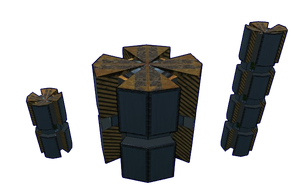Radioisotope Thermoelectric Generator
Overview
Radioisotope Thermoelectric Generators (RTGs) are a component which provides constant energy without expending materials to do so. Batteries are required to store and use energy, electric motors are required to convert energy into power.
Free energy comes at the cost of a high weight, volume, and cost to build compared to other power plants. As such, its most useful for support craft in campaign that do not see combat.
Random Stats
Power Harvesting
Since RTGs do not create power nor store energy on their own, they require batteries to be built on your craft for RTGs to be utilized. In order to efficiently convert RTG energy into power, a craft needs calculate this please m^3 of batteries (and an electric motor) per m^3 of RTG in order to convert 100% of the RTG energy/sec into power.
Time to neutral cost
Since RTGs create energy without expending materials over time, they end up "saving" materials that would've otherwise been spent on fuel/steam. As such, they effectively pay themselves off over time presuming that your rtgs are not destroyed. The time required to be cost neutral is dependent on the power per material (ppm) of the engine you'd otherwise build;
funky formula here

